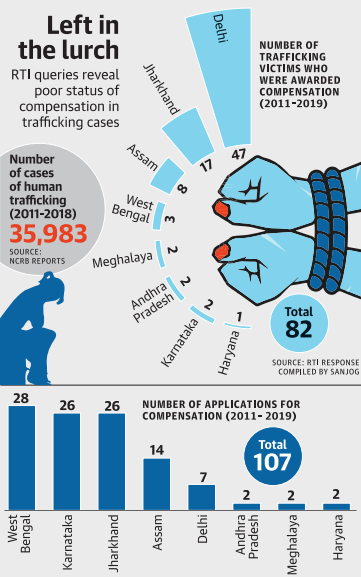Contents:
- Only 82 trafficking survivors awarded relief in last 8 years
- NASA, ESA set to send Solar Orbiter probe to map Sun’s poles
- Arctic ice melt is disrupting key ocean current, may alter climate in Western Europe
- Perumbakkam lake
- Rasa in Indian Music
ONLY 82 TRAFFICKING SURVIVORS AWARDED RELIEF IN LAST 8 YEARS
- Highlighting the poor status of compensation awarded to survivors of human trafficking in the country, response obtained through RTI queries from 25 States and seven Union Territories reveal that between March 2011 and April 2019 only 82 such victims were awarded compensation
- Between 2011 and 2018, the total number of cases of human trafficking recorded in the country, according to NCRB reports, was 35,983. This means, only 0.2% of all survivors of human trafficking received the compensation announced by the government in the last eight years.

NASA, ESA SET TO SEND SOLAR ORBITER PROBE TO MAP SUN’S POLES
Why in news?
- NASA and the European Space Agency (ESA) are gearing up to send a new probe toward the Sun to take a unique look at its blazing poles, an unprecedented view expected to help researchers grasp how the star’s vast bubble of energy affects Earth and humans in space.
- Using the gravitational influence from Earth and Venus to whip itself as close as 26 million miles from the Sun or 95% of the distance between the star and Earth the probe will map the star’s poles, which could allow scientists for the first time to observe the concentrated source of solar wind that permeates our solar system.
- Solar wind is soup of charged particles that are highly concentrated at the poles and beam through our solar system, affecting satellites and electronic devices on Earth.
- Solar Orbiter carries ten instruments packed behind a massive 324-pound (147 kg) heat shield, three of which will peer through tiny windows and face the Sun to survey how its surface changes over time.
ARCTIC ICE MELT IS DISRUPTING KEY OCEAN CURRENT, MAY ALTER CLIMATE IN WESTERN EUROPE
- Ocean water current, which plays a key role in keeping Western Europe warm, could be altered by an influx of unprecedented amounts of cold, fresh water from melting ice in the Arctic
- A seawater current called the Beaufort Gyre keeps the polar environment in balance by storing fresh water near the surface of the Arctic ocean.
- Wind blows the gyre in a clockwise direction around the western Arctic Ocean, north of Canada, where it naturally collects fresh water from the melting of glaciers, and river runoff, the study, published in the journal Nature Communications, noted.
- This fresh water is important in the Arctic since it floats above the warmer, salty water, and helps protect the sea ice from melting – in turn regulating the Earth’s climate.
- However, since the 1990s, the researchers said, the gyre has accumulated a large amount of fresh water – 8,000 cubic kilometres – or almost twice the volume of Lake Michigan in the US.
- The cause of this gain in freshwater concentration is the loss of sea ice in summer and autumn.
PERUMBAKKAM LAKE
- The black-tailed godwit, a near-threatened bird species had arrived at the lake
- The Great Trigonometrical Survey, a Survey of India initiative to survey the whole land mass of India was started from the measurement of a small section of plain land with Perumbakkam Hill on the southern end by Major Lambton in 1802 CE.
RASA IN INDIAN MUSIC
- Bharata Muni enunciated the eight Rasas in the Nātyasāstra, an ancient Sanskrit text of dramatic theory and other performance arts, written between 200 BC and 200 AD.
- In the Indian performing arts, a rasa is a sentiment or emotion evoked in each member of the audience by the art.
- The Natya Shastra mentions six rasa in one section, but in the dedicated section on rasa it states and discusses eight primary rasa.
- Each rasa, according to Nātyasāstra, has a presiding deity and a specific colour.
- There are 4 pairs of rasas.
- For instance, Hāsya arises out of Sringara.
- The Aura of a frightened
person is black, and the aura of an angry person is red. Bharata Muni
established the following:
- Śṛṅgāraḥ : Romance, Love, attractiveness. Presiding deity: Vishnu. Colour: light green
- Hāsyam : Laughter, mirth, comedy. Presiding deity: Shiva. Colour: white
- Raudram: Fury. Presiding deity: Shiva. Colour: red
- Kāruṇyam: Compassion, mercy. Presiding deity: Yama. Colour: grey
- Bībhatsam: Disgust, aversion. Presiding deity: Shiva. Colour: blue
- Bhayānakam: Horror, terror. Presiding deity: Yama. Colour: black
- Veeram: Heroism. Presiding deity: Indra. Colour: saffron
- Adbhutam: Wonder, amazement. Presiding deity: Brahma. Colour: yellow
- Śāntam: Peace or tranquility. deity: Vishnu. Colour: perpetual white
(A ninth rasa was added by later authors. This addition had to undergo a good deal of struggle between the sixth and the tenth centuries, before it could be accepted by the majority of the Alankarikas, and the expression “Navarasa” (the nine rasas), could come into vogue.)




